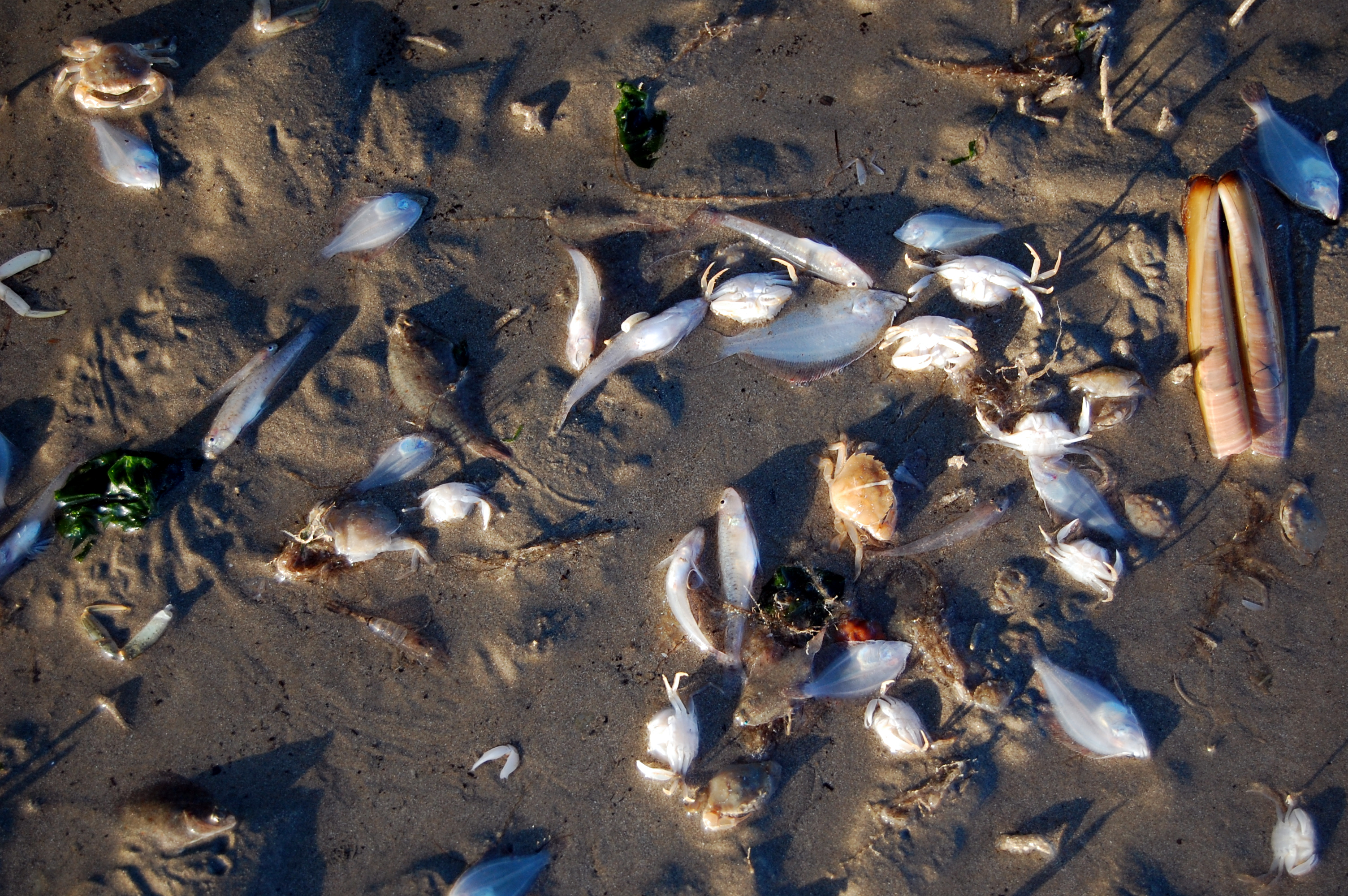|
False Catshark
The false catshark or sofa shark (''Pseudotriakis microdon'') is a species of ground shark in the family Pseudotriakidae, and the sole member of its genus. It has a worldwide distribution, and has most commonly been recorded close to the bottom over continental and insular slopes, at depths of . Reaching in length, this heavy-bodied shark can be readily identified by its elongated, keel-like first dorsal fin. It has long, narrow eyes and a large mouth filled with numerous tiny teeth. It is usually dark brown in color, though a few are light gray. With flabby muscles and a large oily liver, the false catshark is a slow-moving predator and scavenger of a variety of fishes and invertebrates. It has a viviparous mode of reproduction, featuring an unusual form of oophagy in which the developing embryos consume ova or egg fragments released by the mother and use the yolk material to replenish their external yolk sacs for later use. This species typically gives birth to two pups at a ... [...More Info...] [...Related Items...] OR: [Wikipedia] [Google] [Baidu] |
Félix António De Brito Capelo
Felix may refer to: * Felix (name), people and fictional characters with the name Places * Arabia Felix is the ancient Latin name of Yemen * Felix, Spain, a municipality of the province Almería, in the autonomous community of Andalusia, Spain * St. Felix, Prince Edward Island, a rural community in Prince County, Prince Edward Island, Canada. * Felix, Ontario, an unincorporated place and railway point in Northeastern Ontario, Canada * St. Felix, South Tyrol, a village in South Tyrol, in northern Italy. * Felix, California, an unincorporated community in Calaveras County Music * Felix (band), a British band * Felix (musician), British DJ * Félix Award, a Quebec music award named after Félix Leclerc Business * Felix (pet food), a brand of cat food sold in most European countries * AB Felix, a Swedish food company * Felix Bus Services of Derbyshire, England * Felix Airways, an airline based in Yemen Science and technology * Apache Felix, an open source OSGi framewor ... [...More Info...] [...Related Items...] OR: [Wikipedia] [Google] [Baidu] |
Embryo
An embryo is an initial stage of development of a multicellular organism. In organisms that reproduce sexually, embryonic development is the part of the life cycle that begins just after fertilization of the female egg cell by the male sperm cell. The resulting fusion of these two cells produces a single-celled zygote that undergoes many cell divisions that produce cells known as blastomeres. The blastomeres are arranged as a solid ball that when reaching a certain size, called a morula, takes in fluid to create a cavity called a blastocoel. The structure is then termed a blastula, or a blastocyst in mammals. The mammalian blastocyst hatches before implantating into the endometrial lining of the womb. Once implanted the embryo will continue its development through the next stages of gastrulation, neurulation, and organogenesis. Gastrulation is the formation of the three germ layers that will form all of the different parts of the body. Neurulation forms the nervou ... [...More Info...] [...Related Items...] OR: [Wikipedia] [Google] [Baidu] |
Ancient Greek
Ancient Greek includes the forms of the Greek language used in ancient Greece and the ancient world from around 1500 BC to 300 BC. It is often roughly divided into the following periods: Mycenaean Greek (), Dark Ages (), the Archaic period (), and the Classical period (). Ancient Greek was the language of Homer and of fifth-century Athenian historians, playwrights, and philosophers. It has contributed many words to English vocabulary and has been a standard subject of study in educational institutions of the Western world since the Renaissance. This article primarily contains information about the Epic and Classical periods of the language. From the Hellenistic period (), Ancient Greek was followed by Koine Greek, which is regarded as a separate historical stage, although its earliest form closely resembles Attic Greek and its latest form approaches Medieval Greek. There were several regional dialects of Ancient Greek, of which Attic Greek developed into Koi ... [...More Info...] [...Related Items...] OR: [Wikipedia] [Google] [Baidu] |
Nictitating Membrane
The nictitating membrane (from Latin '' nictare'', to blink) is a transparent or translucent third eyelid present in some animals that can be drawn across the eye from the medial canthus to protect and moisten it while maintaining vision. All Anura(tailless amphibians), and some reptiles, birds, and sharks have full nictitating membranes; in many mammals, a small, vestigial portion of the nictitating membrane remains in the corner of the eye. Some mammals, such as cats, camels, polar bears, seals and aardvarks, have full nictitating membranes. Often called a third eyelid or haw, it may be referred to in scientific terminology as the ''plica semilunaris'', ''membrana nictitans'', or ''palpebra tertia''. Description The nictitating membrane is a transparent or translucent third eyelid present in some animals that can be drawn across the eye for protection and to moisten it while maintaining vision. The term comes from the Latin word '' nictare'', meaning "to blink". It is o ... [...More Info...] [...Related Items...] OR: [Wikipedia] [Google] [Baidu] |
Triakis
''Triakis'' is a genus of houndsharks in the family (biology), family Triakidae. The name comes from the Greek language, Greek word τρι, ''tri'' meaning "three", and the Latin word ''acis'' meaning "sharp" or "pointed", in reference to the three-pointed teeth of these sharks. Species See also * List of prehistoric cartilaginous fish References Triakis, Extant Paleocene first appearances {{Shark-stub ... [...More Info...] [...Related Items...] OR: [Wikipedia] [Google] [Baidu] |
Portugal
Portugal, officially the Portuguese Republic, In recognized minority languages of Portugal: :* mwl, República Pertuesa is a country located on the Iberian Peninsula, in Southwestern Europe, and whose territory also includes the Macaronesian archipelagos of the Azores and Madeira. It features the westernmost point in continental Europe, its mainland west and south border with the North Atlantic Ocean and in the north and east, the Portugal-Spain border, constitutes the longest uninterrupted border-line in the European Union. Its archipelagos form two autonomous regions with their own regional governments. On the mainland, Alentejo region occupies the biggest area but is one of the least densely populated regions of Europe. Lisbon is the capital and largest city by population, being also the main spot for tourists alongside Porto, the Algarve and Madeira. One of the oldest countries in Europe, its territory has been continuously settled and fought over since prehistoric tim ... [...More Info...] [...Related Items...] OR: [Wikipedia] [Google] [Baidu] |
Ichthyologist
Ichthyology is the branch of zoology devoted to the study of fish, including bony fish (Osteichthyes), cartilaginous fish (Chondrichthyes), and jawless fish (Agnatha). According to FishBase, 33,400 species of fish had been described as of October 2016, with approximately 250 new species described each year. Etymology The word is derived from the Greek words wikt:ἰχθύς, ἰχθύς, ''ikhthus'', meaning "fish"; and wikt:-λογία, λογία, ''logia'', meaning "to study". History The study of fish dates from the Upper Paleolithic, Upper Paleolithic Revolution (with the advent of "high culture"). The science of ichthyology was developed in several interconnecting epochs, each with various significant advancements. The study of fish receives its origins from humans' desire to feed, clothe, and equip themselves with useful implements. According to Michael Barton (professor), Michael Barton, a prominent ichthyologist and professor at Centre College, "the earliest ichthyolo ... [...More Info...] [...Related Items...] OR: [Wikipedia] [Google] [Baidu] |
Bottom Trawl
Bottom trawling is trawling (towing a trawl, which is a fishing net) along the seafloor. It is also referred to as "dragging". The scientific community divides bottom trawling into benthic trawling and demersal trawling. Benthic trawling is towing a net at the very bottom of the ocean and demersal trawling is towing a net just above the benthic zone. Bottom trawling can be contrasted with midwater trawling (also known as pelagic trawling), where a net is towed higher in the water column. Midwater trawling catches pelagic fish such as anchovies and mackerel, whereas bottom trawling targets both bottom-living fish (groundfish) and semi-pelagic species such as cod, squid, shrimp, and rockfish. Trawling is done by a trawler, which can be a small open boat with only or a large factory trawler with . Bottom trawling can be carried out by one trawler or by two trawlers fishing cooperatively (pair trawling). Global catch from bottom trawling has been estimated at over 30 million tonnes ... [...More Info...] [...Related Items...] OR: [Wikipedia] [Google] [Baidu] |
Longline Fishing
Longline fishing, or longlining, is a commercial fishing angling technique that uses a long ''main line'' with fish bait, baited fish hook, hooks attached at intervals via short branch lines called ''snoods'' or ''gangions''.Method and Apparatus for Long Line and Recreational Bait Fishing Patent application 20080202013. 28 August 2008. A snood is attached to the main line using a clip or swivel, with the hook at the other end. Longlines are classified mainly by where they are placed in the water column. This can be at the surface or at the bottom. Lines can also be set by means of an anchor, or left to drift. Hundreds or even thousands of baited hooks can hang from a single line. This can lead to many deaths of different marine species (see bycatch). Longliners – fishing vessels rigged ... [...More Info...] [...Related Items...] OR: [Wikipedia] [Google] [Baidu] |
Bycatch
Bycatch (or by-catch), in the fishing industry, is a fish or other marine species that is caught unintentionally while fishing for specific species or sizes of wildlife. Bycatch is either the wrong species, the wrong sex, or is undersized or juveniles of the target species. The term "bycatch" is also sometimes used for untargeted catch in other forms of animal harvesting or collecting. Non- marine species ( freshwater fish not saltwater fish) that are caught (either intentionally or unintentionally) but regarded as generally "undesirable" are referred to as " rough fish" (mainly US) and "coarse fish" (mainly UK). In 1997, the Organisation for Economic Co-operation and Development (OECD) defined bycatch as "total fishing mortality, excluding that accounted directly by the retained catch of target species". Bycatch contributes to fishery decline and is a mechanism of overfishing for unintentional catch. The average annual bycatch rate of pinnipeds and cetaceans in the US from 199 ... [...More Info...] [...Related Items...] OR: [Wikipedia] [Google] [Baidu] |
Least-concern Species
A least-concern species is a species that has been categorized by the International Union for Conservation of Nature (IUCN) as evaluated as not being a focus of species conservation because the specific species is still plentiful in the wild. They do not qualify as threatened, near threatened, or (before 2001) conservation dependent. Species cannot be assigned the "Least Concern" category unless they have had their population status evaluated. That is, adequate information is needed to make a direct, or indirect, assessment of its risk of extinction based on its distribution or population status. Evaluation Since 2001 the category has had the abbreviation "LC", following the IUCN 2001 Categories & Criteria (version 3.1). Before 2001 "least concern" was a subcategory of the "Lower Risk" category and assigned the code "LR/lc" or lc. Around 20% of least concern taxa (3261 of 15636) in the IUCN database still use the code "LR/lc", which indicates they have not been re-evalu ... [...More Info...] [...Related Items...] OR: [Wikipedia] [Google] [Baidu] |






